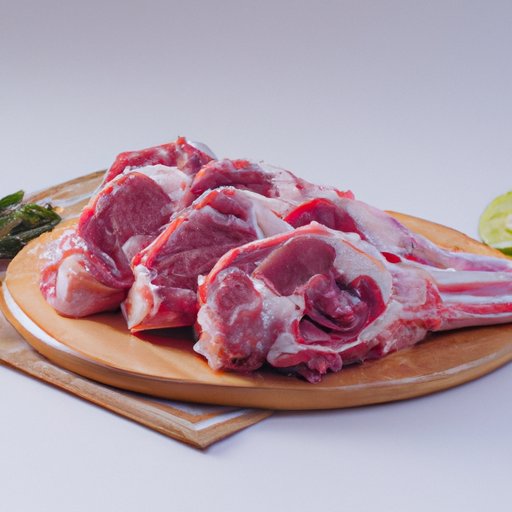Introduction
Lamb is a type of red meat that has been enjoyed in many cultures around the world for centuries. It’s rich in nutrients and offers a range of health benefits, making it an excellent choice for those looking to make healthier food choices. In this article, we’ll explore the nutritional benefits of lamb, how to choose the right cuts, and different ways to cook it.
Nutritional Benefits
Lamb is high in protein, a macronutrient that is essential for growth and development. It also contains several B vitamins, as well as zinc and iron, which are important for maintaining a healthy immune system. Additionally, lamb is a good source of omega-3 fatty acids, which can help reduce inflammation and promote heart health.
Macronutrients
Lamb is an excellent source of protein, with one 3-ounce serving providing approximately 22 grams. Protein helps build and repair muscle, as well as provide energy. Lamb is also low in carbohydrates, with just 1 gram per serving. This makes it a great choice for those following a low-carb diet.
Vitamins and Minerals
Lamb is a great source of several B vitamins, including thiamin, riboflavin, niacin, vitamin B6, and folate. These vitamins help support metabolism and energy levels. Lamb is also a good source of zinc and iron, two minerals that are important for a healthy immune system. Additionally, lamb is a good source of omega-3 fatty acids, which may help reduce inflammation and promote heart health.
Other Health Benefits
Lamb is also a great source of conjugated linoleic acid (CLA), which is known to have anti-inflammatory properties. Additionally, research suggests that CLA may help improve body composition, reduce fat mass, and increase lean muscle mass. Additionally, lamb is a good source of selenium, a mineral that may help protect against certain types of cancer.

How to Choose Healthy Cuts of Lamb
When it comes to choosing the right cuts of lamb, it’s important to understand the difference between the various types. The most common cuts of lamb include leg, shoulder, loin, and rack. Leg and shoulder cuts tend to be fattier and less expensive, while loin and rack cuts are leaner and more expensive. When selecting your cuts, look for ones that are labeled “lean” or “extra-lean” to ensure you’re getting the healthiest option.

Exploring Different Ways to Cook Lamb
Once you’ve selected your cuts of lamb, it’s time to start exploring different ways to cook them. Grilling, roasting, stewing, stir-frying, and broiling are all excellent methods for preparing lamb. Each method has its own unique flavor and texture, so you’re sure to find one that suits your taste buds. Additionally, some methods require less fat than others, so be sure to check the recipe before you begin cooking.
Comparing Lamb to Other Protein Sources
When it comes to selecting a protein source, it’s important to compare the nutrient content of each option. Compared to other sources of animal protein, such as beef, chicken, and fish, lamb is relatively low in saturated fat and cholesterol. Additionally, when compared to plant-based proteins, such as beans and tofu, lamb is higher in certain vitamins and minerals, such as iron and zinc.
Common Lamb-Based Dishes Around the World
Lamb is enjoyed in many different cultures around the world. In India, lamb is often cooked with spices and served in curries or with rice. In the Middle East, it’s typically grilled and served with flatbread. In Greece, lamb is roasted and served with potatoes and vegetables. In China, it’s stir-fried with vegetables. And in the United States, it’s often served as a roast dinner.
Conclusion
Lamb is a great source of essential vitamins and minerals, as well as protein and healthy fats. It’s also a versatile ingredient that can be used in a variety of dishes around the world. To ensure you’re getting the most nutritional benefit from lamb, be sure to select leaner cuts and cook them using healthy methods. Additionally, be sure to compare the nutrient content of lamb to other sources of protein to ensure you’re making the healthiest choice for your diet.
(Note: Is this article not meeting your expectations? Do you have knowledge or insights to share? Unlock new opportunities and expand your reach by joining our authors team. Click Registration to join us and share your expertise with our readers.)
